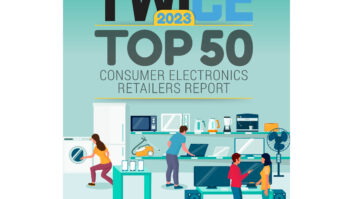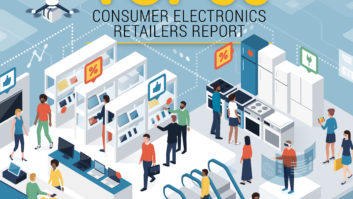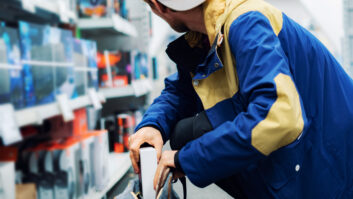LAS VEGAS – Top CE merchants attending TWICE’s annual Executive Retail Roundtable last month at International CES said 4K TV, along with headphones and PCs, helped spur the industry’s best fourth quarter in years.
Also contributing to the glad tidings were controlled promotions, an extended shopping season, a recovering economy, and a growing predilection for mobile shopping.
All this sets the stage for what panelists hope will be continued momentum through the first half of the young year. An edited transcript of the conversation follows.
TWICE: So, was Santa good to the CE industry this past holiday season?
Tom Hickman, electronics senior VP, Nationwide Marketing Group: As much as I would love to think that it is the collective genius of the people in this room, every economic indicator is pointing to the fact that things are on the rebound. Consumer confidence, unemployment and the stock market have been in incredible shape. People are starting to come back. There are discretionary dollars to be spent. Luckily for us, it gets spent in our category.
TWICE: The stars were aligned and gas prices were down. But macro-factors aside, how did the various product categories perform?
Dave Workman, president/COO, ProSource: I would characterize the holiday as probably the strongest we have seen in six or seven years overall. It wasn’t one thing, although television was clearly a standout performer with upside performance in 4K television.
The good news out of all of this is that in all of my years in the business I have found that if you have a strong holiday it tends to be an indicator for the first half of the year.
4K Is King
David Wexler, VP/co-founder, The Little Guys: For us it is about 4K and getting that part of the business started. The margins are there for once in a long time, and if some of the price compression would stop that would be even better.
Because there is another level of performance, what we are seeing is that the original plasma customers, the original SXRD customers, and the customers who bought XBR or a premium product in the early 2000s, are now taking a step. Fortunately, there is a product to fill that spot for them. It’s a $2,000 to $4,000 television, even $7,000 for a 65-inch TV. It’s a beautiful thing.
TWICE: A lot of the promotions, particularly on the TV side, were vendor controlled.
Wexler: From our perspective, there was no reason to lower the prices to the point that they were lowered to. We didn’t sell one more TV because it was $1,299 instead of $1,599, or $1,899 instead of $2,099. That was 100-percent unnecessary from a small, independent’s perspective.
Stephen Baker, industry analysis VP, The NPD Group: TVs were rocking. This was the best TV year we have had in a while with over 9 million units, up 5 percent, and up 1 percent in dollars.
4K was 4 percent of total units, which is amazing considering that the average selling price of a 4K TV was over $1,500. Half of the 4K volume was 55-inch. Another 30 percent of that volume was 60 and above. 4K was 25 percent of all of the 65-inch televisions and 11 percent of the 50-inch and above. Just rocking, great numbers.
Whither Wearables?
TWICE: How’d wearables do over the holiday?
Fred Towns, president, New Age Electronics: The biggest problem we had was being able to get enough. As many new companies come out and introduce their products, they are trying to figure out where the waterline is of where the product is going to go.
It skyrocketed in a lot of cases, and people are really trying to find a different way to use the devices, whether for health or tracking fitness or just to receive their e-mails. Some people want to look at it as a watch or a piece of jewelry with an indicator. Of course the fitness person is always looking at it from the health aspect, and even Apple, when they introduced their new 6 product, embedded a new application in their software that ties in with fitness tracking.
Everybody is acknowledging the fact that it is an important category. People are always trying to find some way to improve their health. There was a lot of request and demand for those types of products. We found that anything that was connected was pretty exciting this year.
TWICE: Laura, are you also responsible for Amazon’s Wearable Technology store?
Laura Orvidas, VP CE, Amazon.com: Yes. I’m a huge fan; I was looking around to see if anyone else has a wearable on today. I’m scoping out new wearables on this trip.
We have 450 wearable technology SKUs, some of them exclusive to Amazon from some new manufacturers. We have the Mio watch, which tracks your heart rate if you don’t want to wear those bands that can be a little bit constricting. Instead you get to wear your watch.
TWICE:Industry expectations going into the holiday season was that wearables would be a popular stocking stuffer. Was that the case?
Orvidas: We continue to see strong growth in wearables and are excited about the category, but it is still in its infancy in terms of adoption. There are still a bunch of consumers out there that are not quite sure how these products interact with their devices or how they are going to help their health. The awareness is growing, and as we figure out how the data will help our lives we will continue to see adoption of wearable technology.
Fifty Days of Grey
Michael Schwab, co-president, D&H Distributing: You could almost call it the end of Black Friday as we knew it. Instead of Fifty Shades of Grey, it was Fifty Days of Grey – grey not being black, and stretched out over 50 days.
Over the month of November and the first 20 days of December is when the momentum hit. I don’t think you had the accelerated price depression with everyone focusing on Black Friday. You had incremental changes with ebbs and flows in pricing throughout the season that allowed people to see profitable opportunities within the holiday that they don’t normally see.
Baker: Where we are seeing more dollars spent certainly in the last couple of years is Thanksgiving week and then the following week, Cyber Week. Those two weeks definitely seem to be gaining share and prominence. Some of that is just the calendar and how many days you have left to go until Christmas.
We tracked about $15.7 billion in sales over five weeks. While that was down over last year, if you take out tablets, which was a total disaster in general and down something like $800 million in revenue from 2013 to 2014, we are basically flat or a little bit up.
Towns: We found that the planning aspect of it was far better this year from the manufacturers and brands that we represent than in years past. In years past, they would see what was starting to stagnate and all of the sudden they would decide to make this move.
Going Mobile
Mehrdad Akbar, VP, wireless, tablets, wearables and connected home, Walmart: Another interesting dynamic we saw was how consumers are shopping. We are seeing a massive proliferation of online shopping. People are buying through their mobile device and picking up in the store. Ten percent of the actual mobile sales are done in the stores. It’s our job to be able to provide 4,300 locations where they can come and actually pick up what they want. Our ability to be there for them regardless of how they want to shop, when they want to shop or where they want to shop really helped our consumers.
Orvidas: Sixty percent of our sales were mobile as we went into the holiday season. What was interesting about that is we did see the mobile percentage accelerate as we got later in the holiday season. We are definitely seeing a consumer change, moving to mobile and away from the PC.
Akbar: We saw that too; about 50 percent of our dot-com traffic came through a mobile device.
TWICE: How far away is the tipping point, when people will choose mobile shopping over desktop throughout the year?
Orvidas: I think people will shop multiple ways. They will continue to shop in stores, they will continue to shop on the PC, and they are going to continue to shop with their mobile devices. It really depends on the customer use case. Sometimes when you want to do research, it’s harder to do that on a phone. They will seek out a PC or a tablet to do that research, and they will have more dedicated time and focus to do that shopping.













